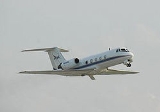
Shuttle Mission Simulator
Encyclopedia
The Shuttle Mission Simulator (SMS) consisted of two simulators in Building 5 and one simulator in Building 35 of Johnson Space Center. The fixed-base simulators included high-fidelity mockups of the flight deck of a Space Shuttle
, as well as a low-fidelity mockup of the middeck. The motion-base simulator consisted of the forward part of the flight deck of the Space Shuttle. It utilized a six-axis hexapod motion system with an additional extended pitch axis to provide motion cuing for all phases of flight.
The motion base simulator provided crews with computer generated visual scenes out of the forward windows only, while the fixed-base simulators supplied forward, aft, and overhead window views. Simulation software modeled all Space Shuttle systems including many pre-programmed malfunctions, response to cockpit controls, and interactions between systems. Before a flight, astronauts logged many hours in these simulators. Instructor stations in the complex allowed simulator instructors to monitor and control student progress in the simulations, including the insertion of malfunctions. A central simulation control office monitored the health of the facility, scheduled its use, and responded to maintenance requests.
Any of the simulators could be interfaced to the Mission Control Center to exercise an integrated simulation. The fixed-base simulators could be interfaced to the Space Station Training Facility to exercise a combined simulation. Simulations which take place without interfacing to the Mission Control Center were called standalone simulations. A full mission rehearsal simulation, involving both the Shuttle and Station simulators, and both Mission Control Centers, was called a dual integrated simulation. Interfacing with payload control facilities at Marshall Space Flight Center, with the control centers of Space Station Program international partners, and with the Neutral Buoyancy Laboratory
was also possible. A dedicated console area in the Mission Control Center, the Simulation Control Area, controlled simulation conduct while integrated.
As of July 2011, the all the simulators in the SMS complex have been mothballed due to the end of the Space Shuttle Program
. They are scheduled to be removed and placed in museums and universities over the course of the next year.
Space Shuttle
The Space Shuttle was a manned orbital rocket and spacecraft system operated by NASA on 135 missions from 1981 to 2011. The system combined rocket launch, orbital spacecraft, and re-entry spaceplane with modular add-ons...
, as well as a low-fidelity mockup of the middeck. The motion-base simulator consisted of the forward part of the flight deck of the Space Shuttle. It utilized a six-axis hexapod motion system with an additional extended pitch axis to provide motion cuing for all phases of flight.
The motion base simulator provided crews with computer generated visual scenes out of the forward windows only, while the fixed-base simulators supplied forward, aft, and overhead window views. Simulation software modeled all Space Shuttle systems including many pre-programmed malfunctions, response to cockpit controls, and interactions between systems. Before a flight, astronauts logged many hours in these simulators. Instructor stations in the complex allowed simulator instructors to monitor and control student progress in the simulations, including the insertion of malfunctions. A central simulation control office monitored the health of the facility, scheduled its use, and responded to maintenance requests.
Any of the simulators could be interfaced to the Mission Control Center to exercise an integrated simulation. The fixed-base simulators could be interfaced to the Space Station Training Facility to exercise a combined simulation. Simulations which take place without interfacing to the Mission Control Center were called standalone simulations. A full mission rehearsal simulation, involving both the Shuttle and Station simulators, and both Mission Control Centers, was called a dual integrated simulation. Interfacing with payload control facilities at Marshall Space Flight Center, with the control centers of Space Station Program international partners, and with the Neutral Buoyancy Laboratory
Neutral Buoyancy Laboratory
The Neutral Buoyancy Laboratory is an astronaut training facility maintained by and located at the Sonny Carter Training Facility on NASA's Johnson Space Center in Houston, Texas. The NBL consists of a large indoor pool of water, the largest in the world, in which astronauts may perform simulated...
was also possible. A dedicated console area in the Mission Control Center, the Simulation Control Area, controlled simulation conduct while integrated.
As of July 2011, the all the simulators in the SMS complex have been mothballed due to the end of the Space Shuttle Program
Space Shuttle program
NASA's Space Shuttle program, officially called Space Transportation System , was the United States government's manned launch vehicle program from 1981 to 2011...
. They are scheduled to be removed and placed in museums and universities over the course of the next year.

